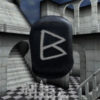The symbolism is necessary to understand as we begin to discuss rune magick, but it isn’t sufficient by itself. Rune magick is contemplative rather than ritualistic which is why you rarely hear about it. People prefer collections of things to do rather than things to understand.
The significance of all the runes (the word rune roughly translating to our word mystery) is that they are not only abstract symbols of naturally occurring concepts or sounds, but they are natural physical depictions of the spirit behind the rune, connected to it and part of its essence. This actually fits much of what cognitive science is saying about the relationship between language and perception, even language and emotion or instinct. Just a word can set you up to perceive instances of related ideas. They call this “priming.” Suggestions of food will trigger a stream of thoughts about food, even feelings about food.
The practice element of rune magick was really very simple. In their craft work they included the runes that were relevant to the tools purpose, or were thought to impart virtues on the owner of the item. So something bearing this Berkana rune would be good for bravery, as well as health and fertility. Shamans were especially passionate practitioners of rune crafting though it was by no means confined to them.
The symbol triggers this correct? The symbol can trigger this, but rune magick is more than just a system of perceptual association. Each rune is used perhaps not unlike Native American totem symbolism. In the case of berkana, the seeker would use the berkana as a focus for their thoughts similar to the eastern practice of using mantras, and in contemplating it’s mystery or “wyrd” (which though it’s pronounced like our word weird actually means something more like the word ‘word’ itself), but through contemplating the spirit of the rune berkana they could awaken that spirit in themselves. By attuning oneself to the spirit of the birch, they could come to understand and thus have the powers of protection, rebirth and healing, as well as improved powers of foresight. Training in rune craft wouldn’t be like we practice in modern day schools related to our alphabet.
So we would put it on the tool that most requires you to have these things in its operation? Indeed. Rather than getting the apprentice to memorize the entire set of runes in order, or learn rules for putting them together in “meaningful” units like words, they would be taught one rune at a time, and drilled in the mystery behind it. In entirety, rune crafting would serve both as a system for preparing the apprentice for understanding anything in the world, and as a memory device for recalling their traditional lore as well.
The reason runes are all shaped with straight lines is originally they were all meant to be carved. They did not have access to ink really, and even when they did, didn’t perceive it to be very practical. If whatever you were writing didn’t need to last, they didn’t consider it worth writing. Rune staffs themselves were also primarily carved into birch wood, as it being the spirit of mothers, would preserve the intention and nurture the growth of whatever intention was expressed by the rune set.
Rune crafting and rune lore is not really the same as the literacy we know today. They wouldn’t make a point of using all the runes. Even though they likely understood all of them, each person would feel a connection to a smaller subset of runes in their lifetime. Things relating to their self-knowledge or their chosen skill set, and they would use different runes at different times. Many of the oldest items bearing runes on them defy translation simply because they are not phrases as we understand letters to be, but more like abstract chains of thought similar to Egyptian hieroglyphs.
Or Chinese characters. Yes, but the basis behind rule magick is simple, and it’s a universal law of magick in general. What you understand, you become. What you name yourself, you are. This was practiced by the original Native American culture as well. To the natives, Crazy Horse was kin to horses, and this wasn’t seen as anything like unnatural or insulting.
The historical figure of Crazy Horse wasn’t named Crazy Horse because he wasn’t sane. His people didn’t really have the concept of insanity. Their take on what the whites meant by the word crazy they understood to be wild or spirited. So it would have the meaning of spirited horse of spirit horse, and actually is quite well trusted imagery.
Your thoughts are welcome. Be well friends.
Travis Saunders
Dragon Intuitive
~science,mysticism,spirituality~



Leave a Reply